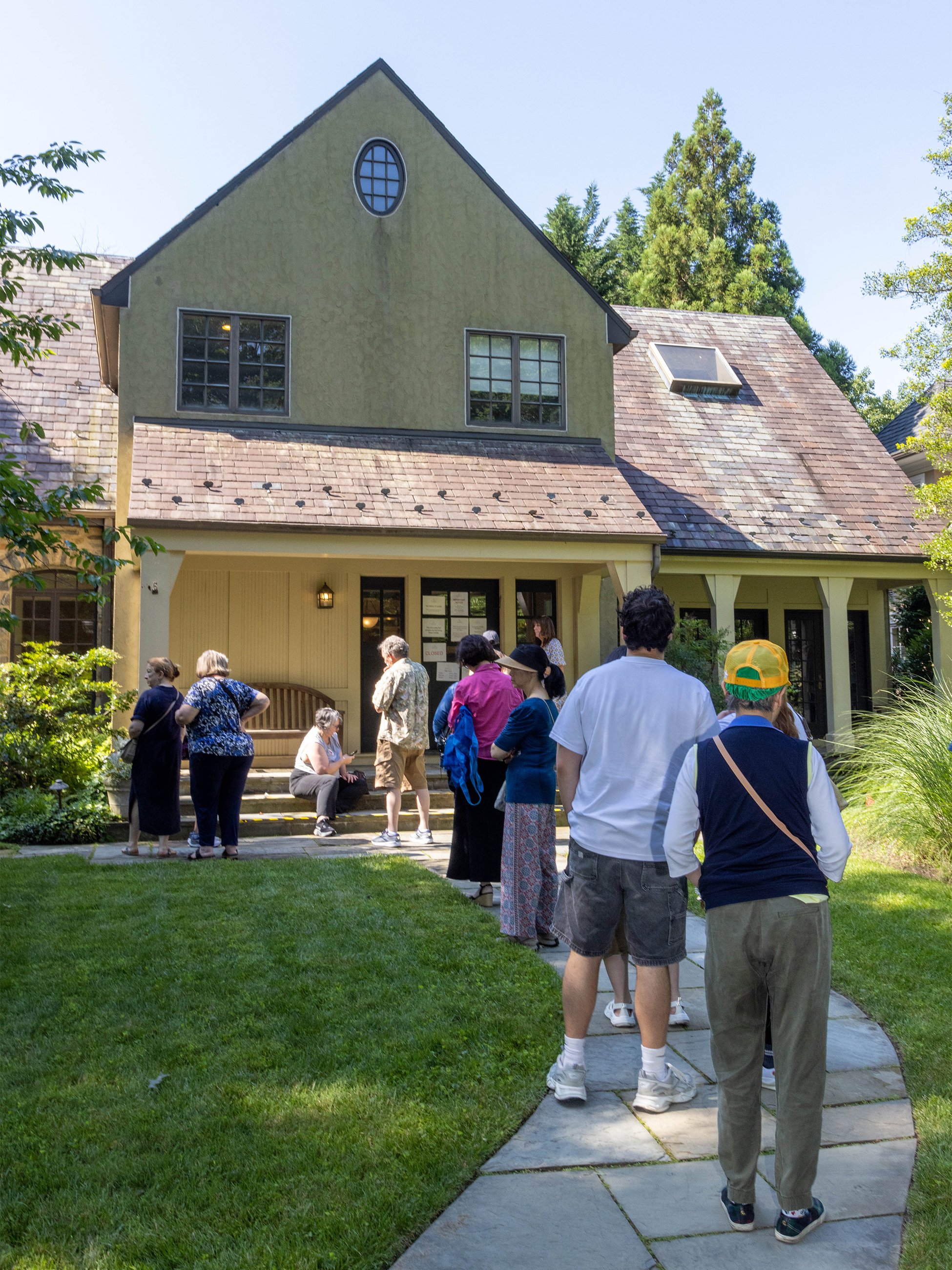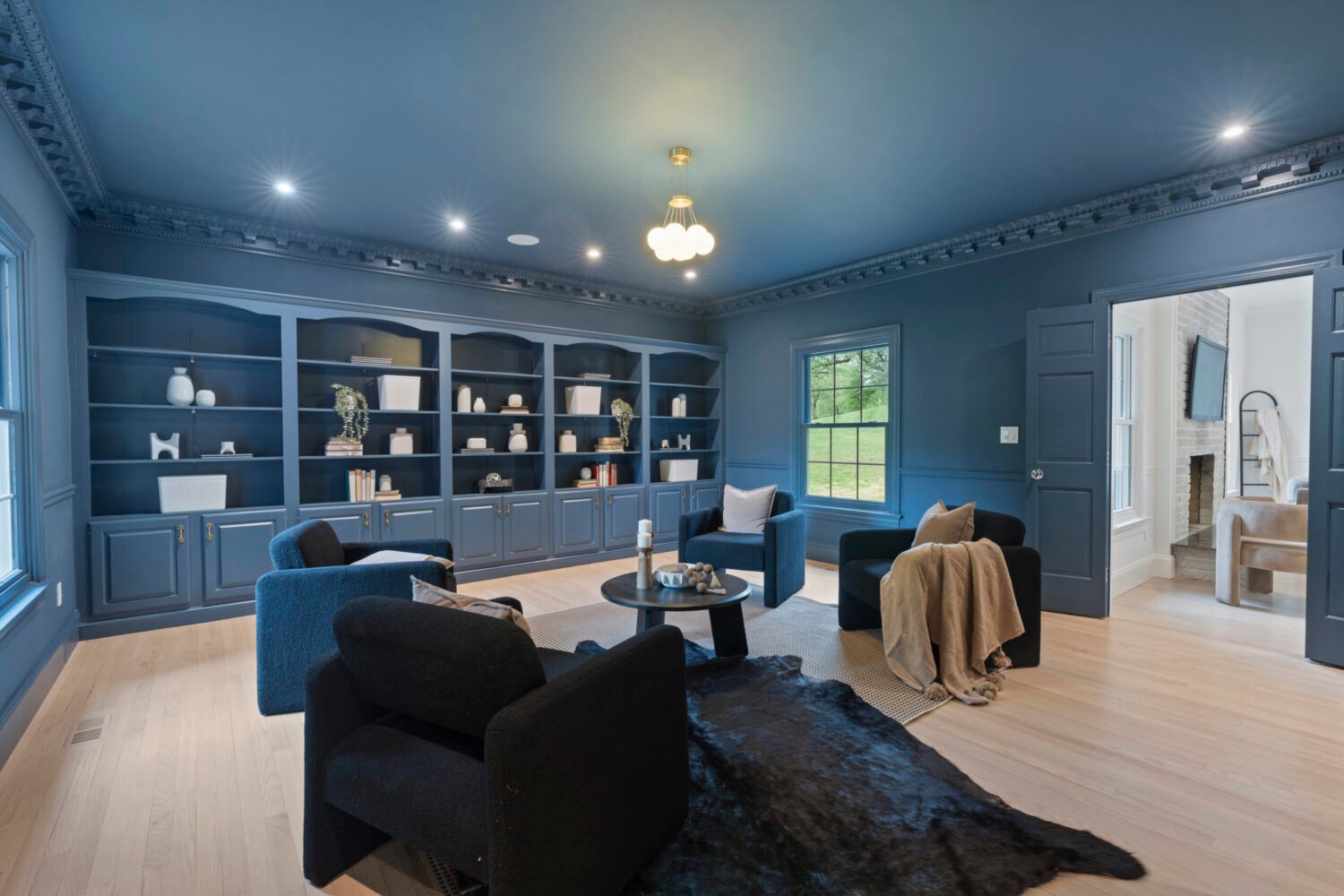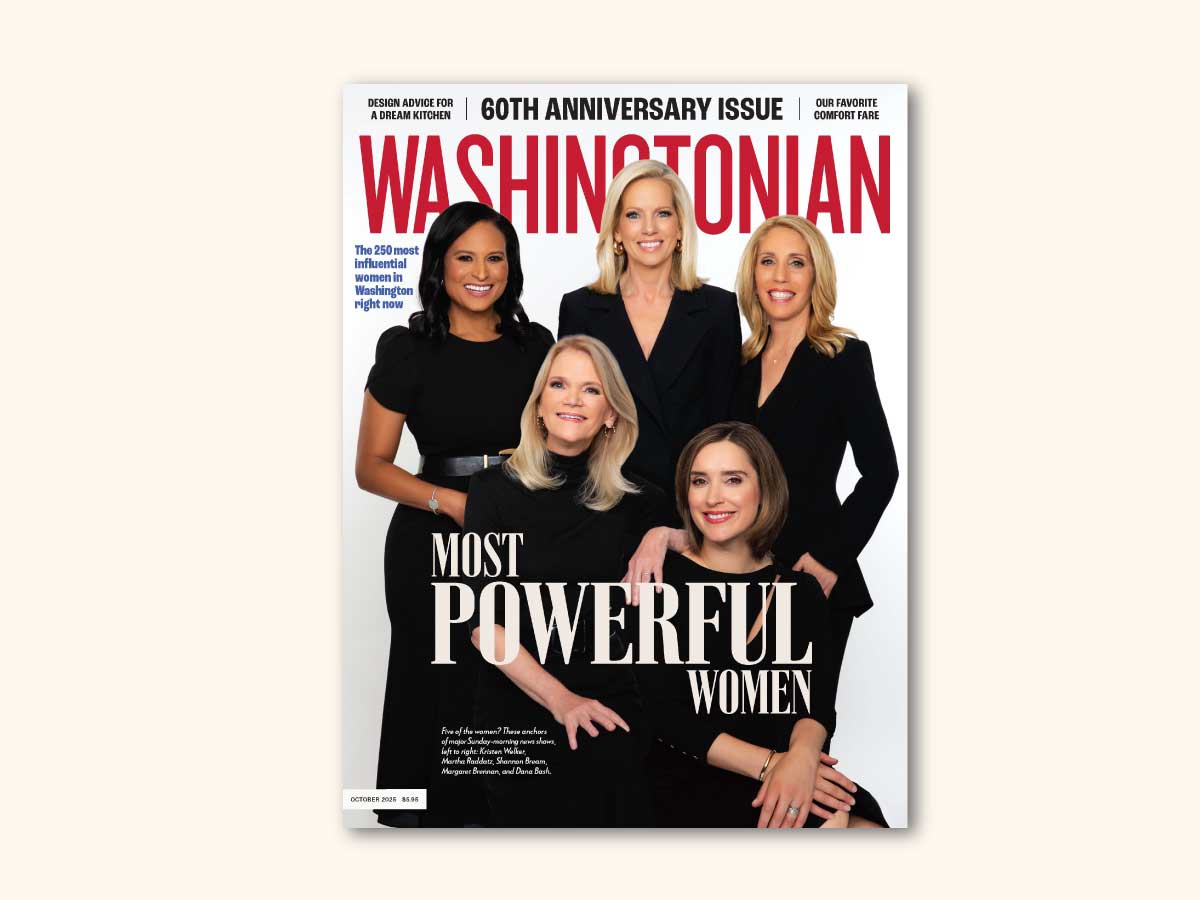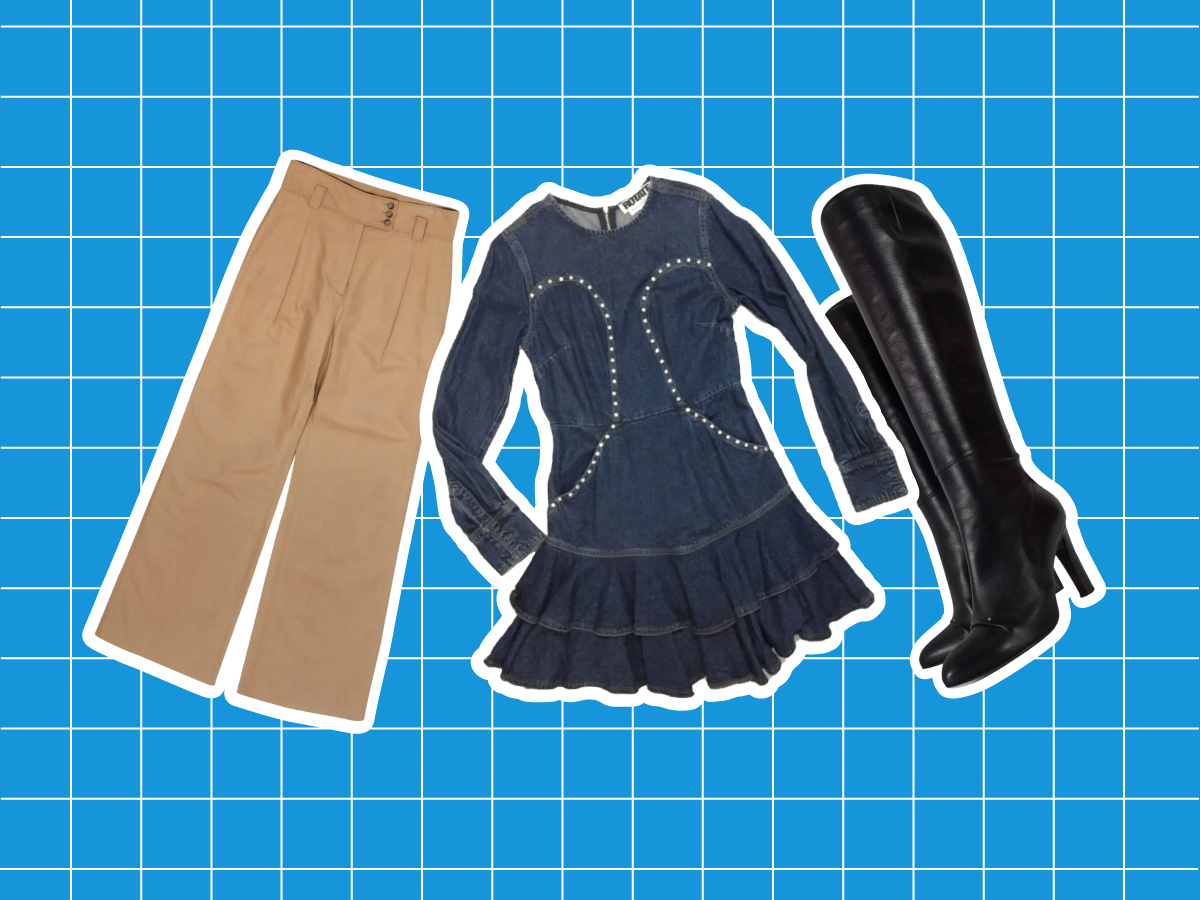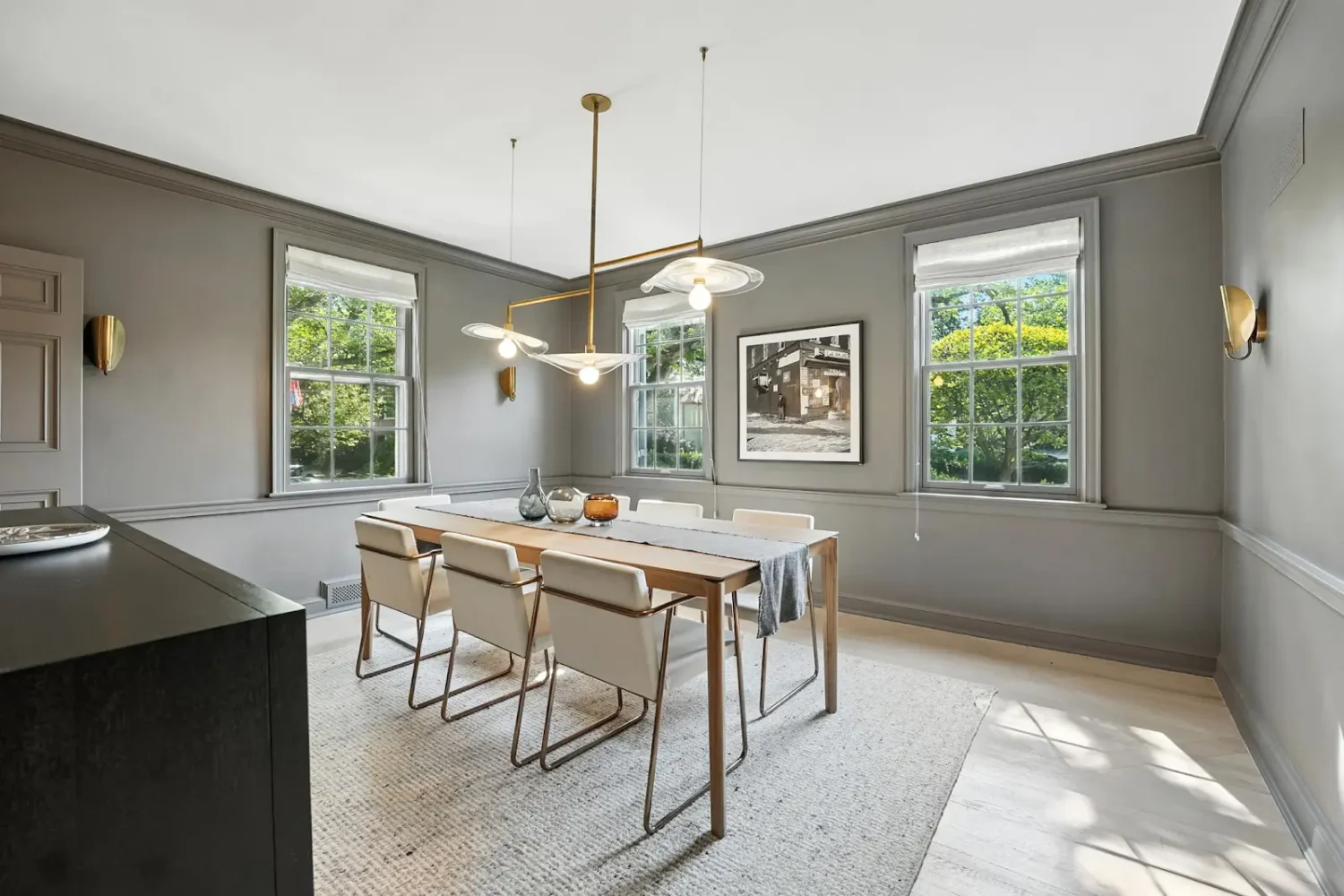I don’t remember my first. But I remember the first one that stirred my imagination, that seduced me with its charms. It was a Saturday morning, April 2021. The house was a stately brick manse on a corner lot in Chevy Chase, a pair of small concrete lions guarding the door. A crowd had gathered by the time I arrived, congregating on the lawn and in front of the brick-and-wrought-iron gates, everyone wearing masks because of the pandemic. We had come because, as estate sales go, this one had star power.
“He was a Pulitzer Prize–winning columnist for the New York Times and a speechwriter for President Nixon. She is an accomplished jewelry designer,” the advertisement on EstateSales.net read. He was William Safire, and she was Helene Safire, née Helene Belmar Julius—not just a jewelry designer but a model and a classical pianist. In the ’90s, I had dipped into Safire’s “On Language” columns in the Times, enamored by the musings of a man who had coined the phrase “nattering nabobs of negativity” to lampoon Nixon’s critics. Charmed by his alliterative prowess, if not his politics, I couldn’t resist the chance to peek inside his house.
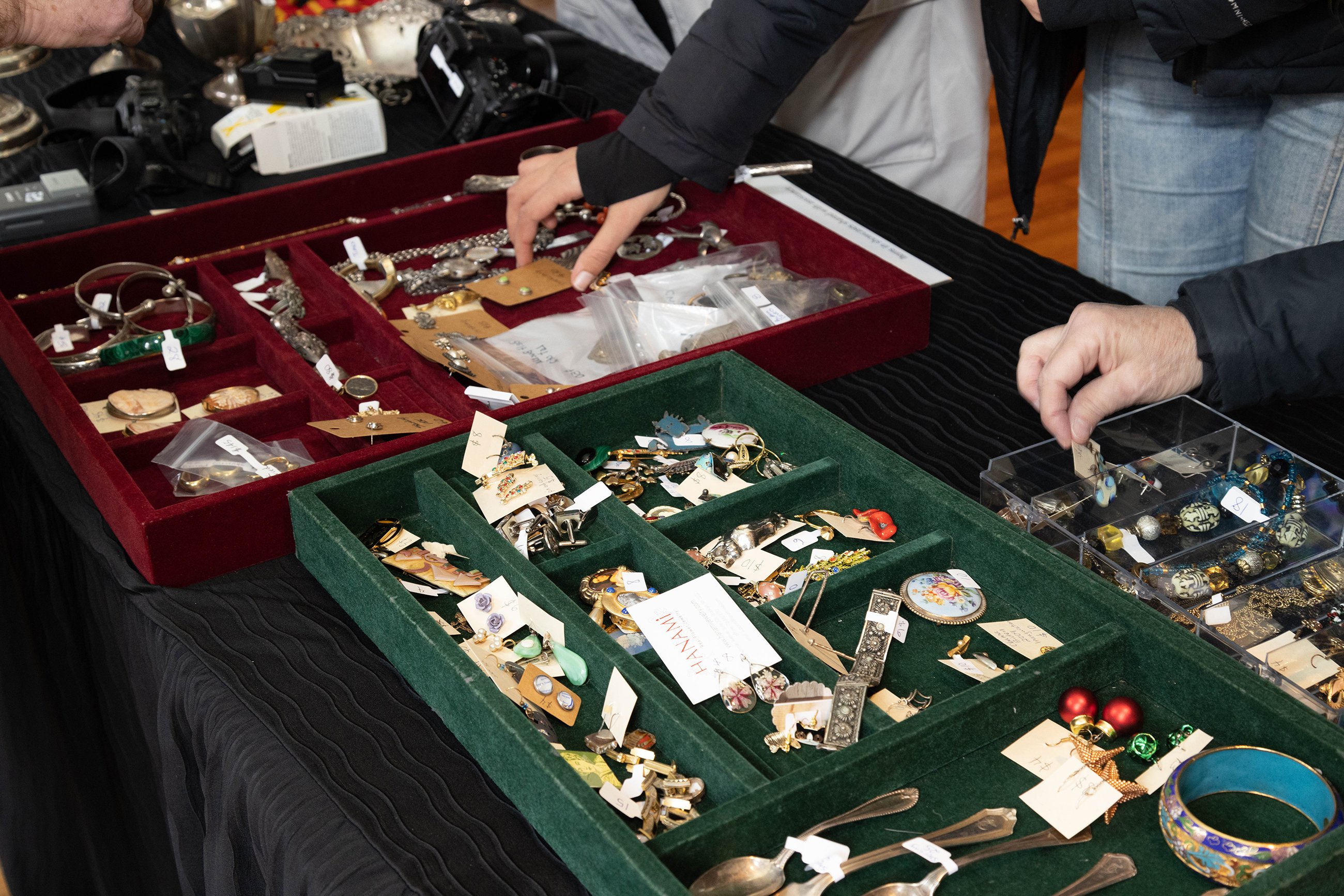
Estate sales, especially high-profile ones, usually require waiting—lots of waiting. Most feature a list: first to arrive, first inside when the sale begins, usually at 9 or 10 am. This one handed out numbers, in my case something approaching triple digits. Safire had passed away from cancer in 2009, and Belmar Julius had finally decided to downsize, selling the property for $2.6 million a few weeks before the sale. When my number was called, it was like stepping into a house museum, but more intimate. Safire with Nixon, Henry Kissinger, Spiro Agnew—a collection of signed photographs lined the walls. I was drawn to his office, awash in books, including dozens of copies of his own novels. The choice offerings were, by then, long gone: The majority of his book collection—many copies inscribed—had been purchased for tens of thousands of dollars by area shops Wonder Book and Capitol Hill Books.
But there were treasures still to be found. In the kitchen, tucked into a corner, I discovered mine: a midcentury rosewood bar cart by Danish designer Ludvig Pontoppidan. The handle was cracked, the finish worn, but one could imagine Safire pouring himself a bourbon, neat, soda on the side—his go-to order—before retiring to his office to finish a column. The price, $300, was a bit steep given the condition. So, as some sales allow, I placed a bid, $160, and waited to hear my fate.
Estate sales are nearly always precipitated by a major life event—divorce, downsizing, bankruptcy, death. More comprehensive than a garage sale, they usually include the bulk of someone’s possessions, perhaps even a vintage Mercedes or Thunderbird. On any given weekend, crowds flock to the dozens of sales in the area. There are the obsessives, always hunting for treasures, for whom estate sales constitute a clinical addiction. There are the gawkers, enthralled by a glimpse inside the house of a neighbor or local celebrity. There are the big-name dealers, who haul off the designer furniture and jewelry. There are the collectors, who deal in comic books or vintage LPs. There are the pickers, who might flip their finds—a midcentury desk, a Persian rug—on Instagram or Facebook Marketplace. There are the casuals, enticed by the promise of scoring Prada shoes for a discount or a bespoke piece of art for their apartment.
I straddle a few of these categories. At the start of the pandemic, estate sales moved online. Because supply chains were snarled and almost everyone was embarking on some kind of redesign as they hunkered down at home, bidding could be intense, a Cabernet-fueled, logic-defying showdown. I, too, was looking for furniture, specifically a vintage Womb Chair that my upholsterer, a former Knoll employee, could refashion in velvet. Like so many others, I realized I could sell a few pieces on the side for extra cash. And so I joined the host of flippers who hung out their shingle during the pandemic. When in-person sales returned, I started going to those, too.
The lure is in the hunt. In 2005, at an estate in Louisiana, a collector bought a painting for less than $10,000; it turned out to be Leonardo da Vinci’s “Salvator Mundi,” which sold at auction in 2017 for $450 million. Big scores have become less common in the age of Google Lens, which makes it easier to identify pricey antiques.
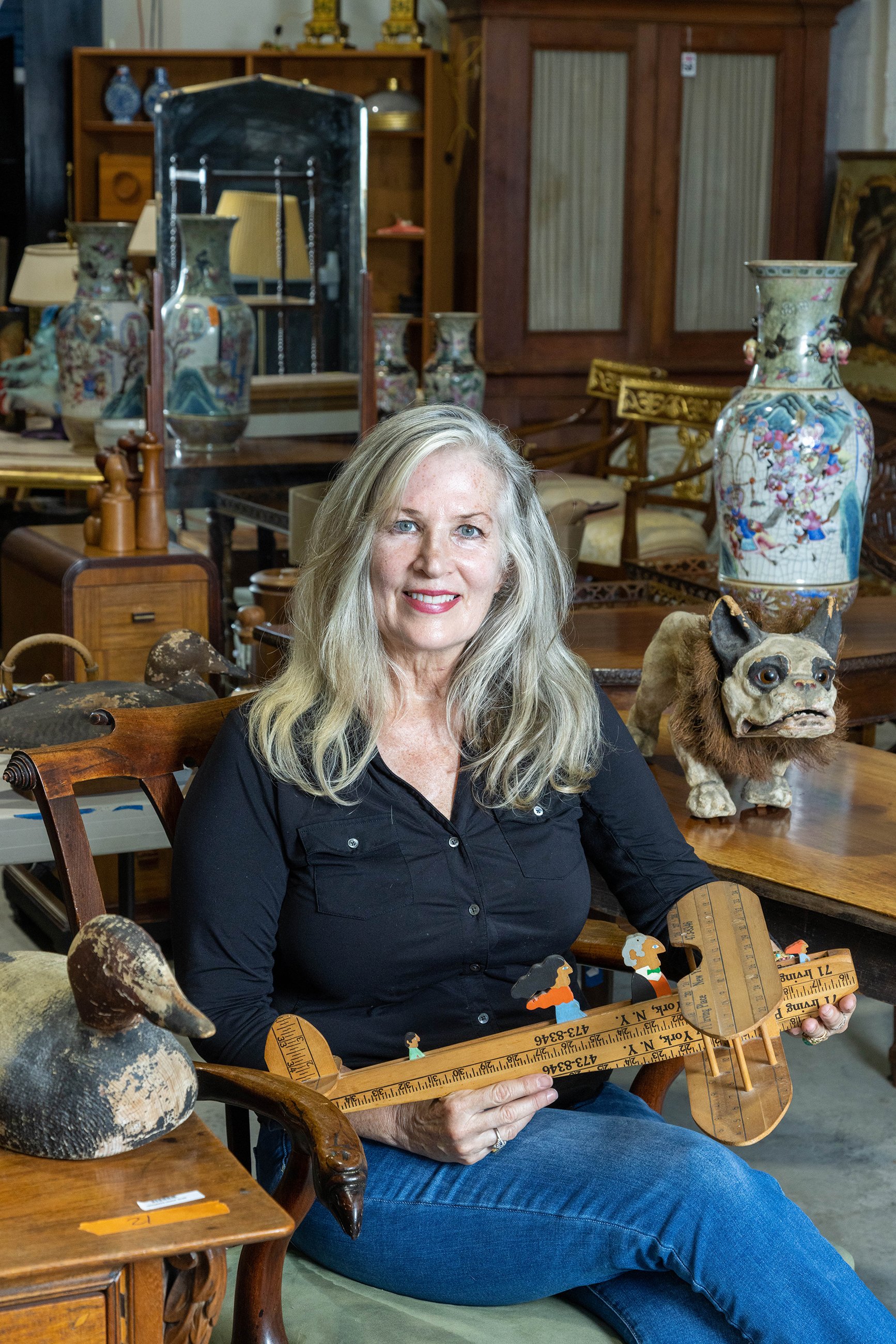
What’s hot now? According to Lori James, owner of Ararity Services, a downsizing-and-auction company in Alexandria, high-end art glass, Baccarat crystal, vintage Legos, rare vinyl records, designer clothing, furniture by the woodworker George Nakashima, and paintings by the late Gene Davis, a DC artist whose works are displayed at the National Gallery of Art and the Phillips. And, with precious metals at all-time highs, gold and silver. “Silver brings the dealers in, but it’s for weight,” says Patti Silverstein, a co-owner of Metropolitan Estate Sales in Lanham, which ran the Safire sale. “They come with their scales, they come with their acid.” Books have enjoyed a post-pandemic resurgence, reports Joanna Shreve Cady, owner of Bethesda’s Savvy Downsizing & Estate Sales. And, of course, anything midcentury modern, my preferred beat.
The voyeuristic thrill holds equal sway, at least for me. A novelist bereft of ideas need only spend a weekend visiting sales and the outlines of countless domestic dramas will emerge. Last year, I attended a sale at the Cathedral Heights house of a Los Angeles Times editor who, sometime in the 1990s, had opened a European bureau for the newspaper. Michelin and Blue guides to France, posters of Chartres, “French Made Easy” VHS tapes—everywhere the trappings of that expat life, from an age when newspaper correspondents oozed glamour.
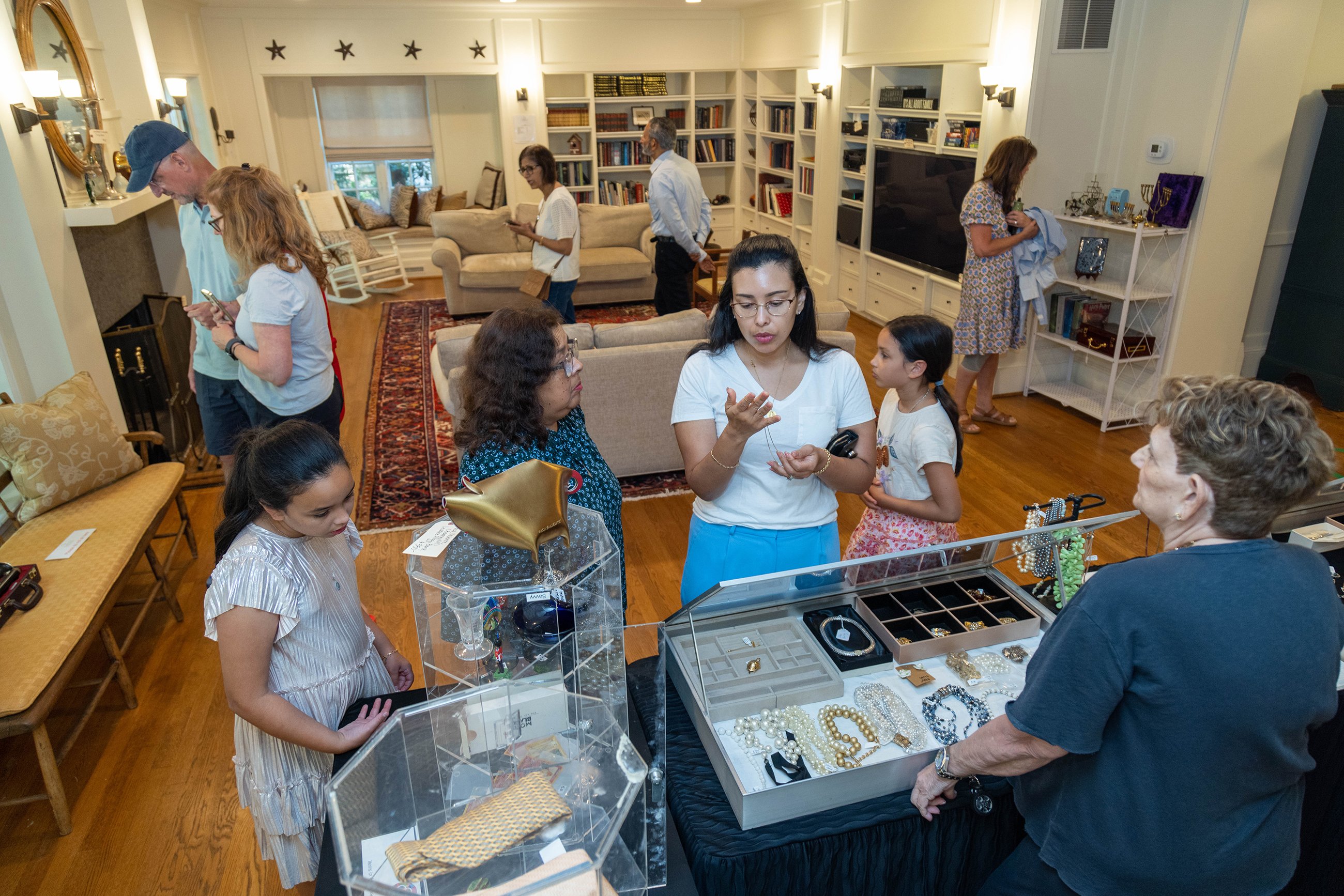
A similar nostalgia informs tales from the golden age of estate sales. Karen Jones, owner of Greater Washington Estate Services, remembers one she did for Betty Beale, a gossip columnist for the Washington Star who died in 2006. In the attic, Jones found a suitcase full of letters. “Betty dear,” read one, “please don’t worry about the President’s shirt. You were so kind to have it cleaned. The flowers were lovely. Mamie.” An artifact from a dinner with the Eisenhowers, one of countless pieces of Beale ephemera that Jones unearthed and sold. In 2018, she hosted one for the late senator and astronaut John Glenn at his Potomac house. “People slept on the front lawn. There were helicopters overhead. I heard from every magazine: Newsweek, People,” she recalls. The Marine Corps Museum purchased one of Glenn’s flight jackets listed for $28,500. Silverstein remembers staging a sale in Bethesda for Edith Ronne, the first American woman to set foot on Antarctica: “We had penguins coming out the wazoo.” And one she hosted for two swingers in their fifties, who had a sex room in their house with belts, chains, and costumes. She and her team uncovered party photos as they prepped for the sale—artifacts from a secret life, one requiring discretion.
Post-pandemic, in-person sales seem, much like the items themselves, a relic. Online auction sites have proliferated—AuctionNinja, CTBids, MaxSold—making it easier to sell your own valuables or host an estate sale online, with pickup at the home for winning bidders. James, the co-owner of an estate-sale company before starting Ararity, launched her own auction house during Covid. Each week, she brings in about 15 truckloads of items from local estates and sells more than a thousand lots. “If there’s treasure in the house, this girl’s gonna find it,” says James, who once scored a $20,000 Picasso vase for $4 at a Maryland garage sale.
And yet the in-person sale has demonstrated surprising staying power. For one thing, the auction model makes less sense for inexpensive items: glassware, old games, knickknacks. For another, the community that’s developed around in-person sales remains a draw. “We missed our people,” says Shreve Cady about the pandemic hiatus. “It’s a different shopper who comes for the experience than one who’s looking online to add the perfect lamp to their living room.”

For those who fear that the estate-sale audience may be graying out, I present Maddy Brannon, a 34-year-old standup comic who began attending sales when she was decorating her Brightwood Park rowhouse with her husband. “All my art is from estate sales,” she says. “That’s how it started.” Lamps, rugs, side tables, glassware, a decorative goldfish bowl from a former Smithsonian employee: As Brannon post-ed her finds on social media, she discovered an audience—64,000 strong on Instagram—and now authors a weekly Substack blast spotlighting the best sales in the region.
I experienced the Brannon effect firsthand last October when I attended an Alexandria sale she featured with a heavyweight list of designer names: Louis Vuitton, Versace, Prada, Dior. The intrigue: The sale appeared to be for Corrine Brown, the former Democratic congresswoman from Florida who was charged with fraud for her involvement in a charity slush-fund scheme and served nearly three years in prison. The crowd skewed young; they sifted through the designer clothing with the insatiability of a fighter breaking fast. As for me, it marked the first time seeing a congresswoman’s bra.
In June, I encountered a listing for an estate sale unlike any I had ever seen. “I’m a performance artist, and I’m turning my post-marital estate sale into a filmed performance and documentary,” the Facebook ad read. “This is more than a sale. It’s a conversation about change, identity, sacrifice, and starting over.”
On a Sunday afternoon, I pulled up to a midcentury-modern house in Alexandria’s Waynewood neighborhood. The front lawn was filled with art, glassware, vintage barstools, Ikea chairs—everything that the host, Jodi Askew, was unable to squeeze into a Honda Fit before embarking on a cross-country road trip to start a new life, post-divorce, in Portland. The emotional backstory of a sale usually remains a veiled mystery—but not here.
“I was in a ten-year relationship with a really good man, and through the course of that relationship, I realized I was queer,” Askew, 31, who uses they/them pronouns, said in their living room turned studio, as a film crew recorded. “I didn’t really want the domestic life I thought I wanted.”
For five hours, a stream of shoppers/subjects sat with Askew and the film crew, sharing stories of love, loss, and self-discovery—a pandemic marriage to a man in Denmark gone wrong, the struggles of being queer in an immigrant family—as some of Askew’s friends logged sales outside. At one point, three recent college grads, one of them wearing a WHITE DUDES FOR HARRIS T-shirt, haggled over the price of a midcentury-style bedside table and a green bench—the trio had just moved to Bloomingdale and were furnishing a group house. Askew asked them if they wanted to be part of the documentary. One of them, sporting a mustache and a newly acquired cactus print, was game, and as his housemates loaded their purchases into a Subaru Outback, he discussed his first love and the challenges of getting sober.
How hard was it to part with so many possessions? “Seeing the things I procured at much simpler times in my life” left Askew “mourning that innocence.” But “having them live on with somebody else who sees them with fresh eyes feels beautiful.”
In early 2022, I found myself on the other side of a sale when my mother passed away. She had been a flea-market obsessive and had amassed a basement of finds in her New Jersey townhouse that she intended to resell but never got around to: Danish Modern furniture, sterling-silver flatware. I kept various heirlooms but called in an estate-sale company for the rest, a lifetime’s worth of possessions—vintage clothing purchased in London in the ’60s, the secretary desk from my childhood bedroom. I was grieving and vulnerable, needed someone I could trust, and had accepted that the commission—companies typically take 35 to 45 percent of the proceeds—was worth the convenience. And, for a little extra cash post-sale, the company recycled and donated the leftovers and trashed the final remainders, leaving an empty basement.
I didn’t attend the sale; I didn’t want to see the masses wrangling over my mom’s possessions. I don’t think she would have much liked it. But now when I visit a sale, I feel like I’m communing with her spirit, sharing in the chase. Especially at one precipitated by a death, I’m attuned to life’s evanescence, reminded that my time will also come.
Which brings me back to that rosewood bar cart. The Sunday after I attended the Safire sale, I got the call. I had won it. My local one-man furniture shop repaired the crack in the handle and refinished it. There was no obvious place for it in our house, so I decided to list it and found a buyer on Facebook Marketplace—a collector of midcentury furniture. I turned a small profit, and for a brief moment I owned a relic from old Washington, which will undoubtedly get handed down again, in a cycle of conservation that will continue long after I’m gone.
Estate-Sale Tips
Need to host a sale? Here are suggestions for finding a company.
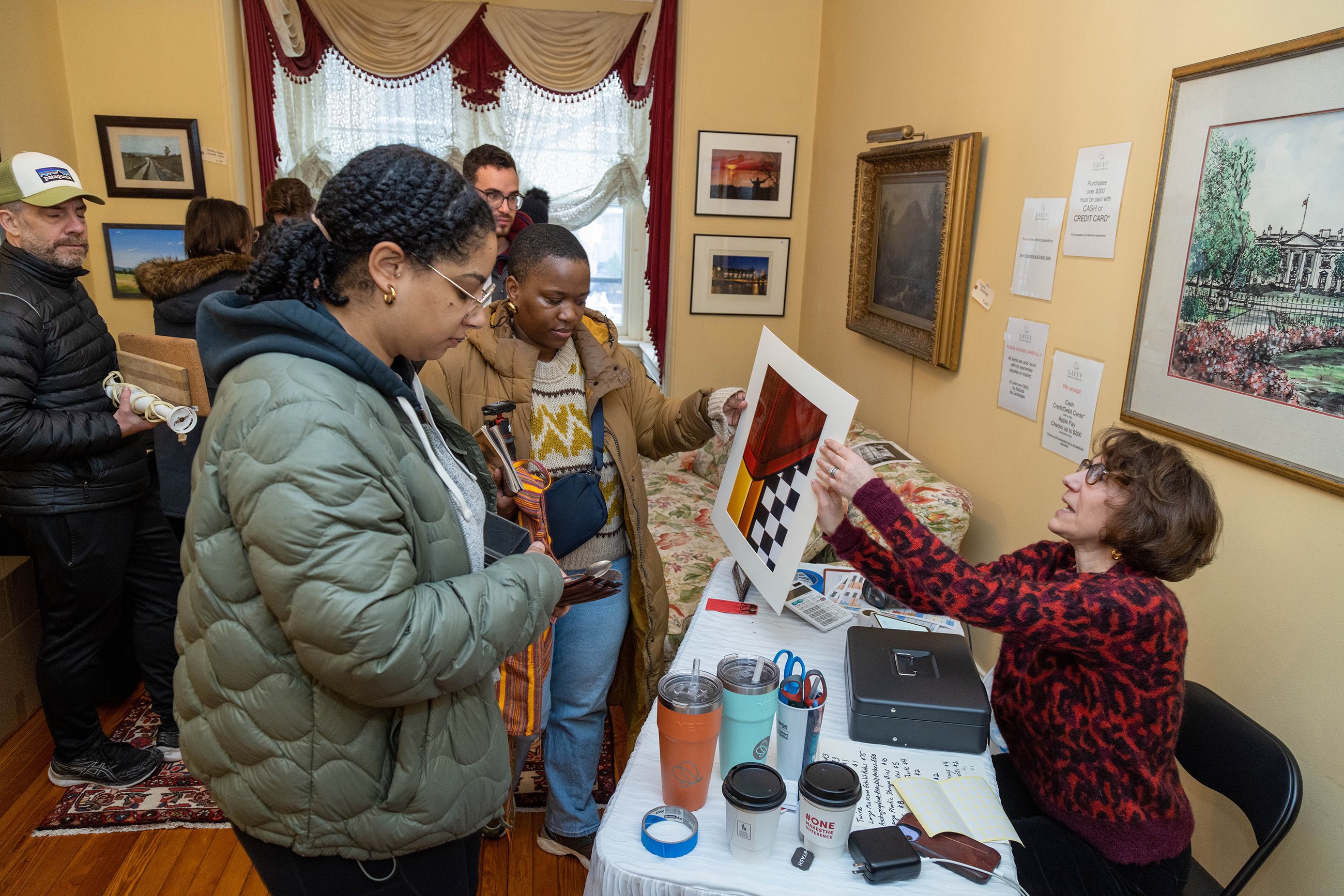
Do Your Research
Few rules and restrictions govern the estate-sale business. For starters, check references and online reviews, and ask questions. “Do you have a business license? Are you insured ?” says Karen Jones of Greater Washington Estate Services. The American Society of Estate Liquidators offers certification; it lists qualified individuals on its website who have agreed to abide by the society’s code of ethics. Stories abound of dealers or friends and family of the company getting first crack at choice items before a sale, for example. You want someone who will look out for your best interests.
Get It in Writing
Make sure to sign a contract that considers all the potential contingencies of a sale and that lays out specific fees, if any, for cleaning post-sale or consigning or tossing leftover items.
Manage Your Expectations
Those shelves of Delft pottery that your mom collected as an investment? They now go for a song. Check recent sales on LiveAuctioneers.com or eBay or to get a sense of the going rate for antiques. Most companies will bring in appraisers to help price more obscure items.
Keep the Threads
A lot of people will offload all the clothing in a house before staging a sale. But that’s a mistake, says estate-sale influencer Maddy Brannon. Vintage clothing can draw people in: “It’s actually a pretty important piece of the sale.”
And if you’re looking to score a bargain, consider this advice:
Pick the Right Sales
Estate sales come in many forms. Some are expertly curated—they tend to have higher prices but more refined offerings. And some are glorified garage sales, with items tossed into boxes. Check out the listings and photos on EstateSales.net or Facebook Marketplace to get a sense of what a sale might have.
Make a Last-Minute Offer
Most sales run for two or three days over a weekend, and some companies drop prices by a predetermined amount each day: 50 percent off on the last day, for instance. Scoring a deal gets easier in the waning hours. For items with big sticker prices, companies may decide to consign them to auction, so be realistic when making a bid.
I don’t remember my first. But I remember the first one that stirred my imagination, that seduced me with its charms. It was a Saturday morning, April 2021. The house was a stately brick manse on a corner lot in Chevy Chase, a pair of small concrete lions guarding the door. A crowd had gathered by the time I arrived, congregating on the lawn and in front of the brick-and-wrought-iron gates, everyone wearing masks because of the pandemic. We had come because, as estate sales go, this one had star power.
“He was a Pulitzer Prize–winning columnist for the New York Times and a speechwriter for President Nixon. She is an accomplished jewelry designer,” the advertisement on EstateSales.net read. He was William Safire, and she was Helene Safire, née Helene Belmar Julius—not just a jewelry designer but a model and a classical pianist. In the ’90s, I had dipped into Safire’s “On Language” columns in the Times, enamored by the musings of a man who had coined the phrase “nattering nabobs of negativity” to lampoon Nixon’s critics. Charmed by his alliterative prowess, if not his politics, I couldn’t resist the chance to peek inside his house.

Estate sales, especially high-profile ones, usually require waiting—lots of waiting. Most feature a list: first to arrive, first inside when the sale begins, usually at 9 or 10 am. This one handed out numbers, in my case something approaching triple digits. Safire had passed away from cancer in 2009, and Belmar Julius had finally decided to downsize, selling the property for $2.6 million a few weeks before the sale. When my number was called, it was like stepping into a house museum, but more intimate. Safire with Nixon, Henry Kissinger, Spiro Agnew—a collection of signed photographs lined the walls. I was drawn to his office, awash in books, including dozens of copies of his own novels. The choice offerings were, by then, long gone: The majority of his book collection—many copies inscribed—had been purchased for tens of thousands of dollars by area shops Wonder Book and Capitol Hill Books.
But there were treasures still to be found. In the kitchen, tucked into a corner, I discovered mine: a midcentury rosewood bar cart by Danish designer Ludvig Pontoppidan. The handle was cracked, the finish worn, but one could imagine Safire pouring himself a bourbon, neat, soda on the side—his go-to order—before retiring to his office to finish a column. The price, $300, was a bit steep given the condition. So, as some sales allow, I placed a bid, $160, and waited to hear my fate.
Estate sales are nearly always precipitated by a major life event—divorce, downsizing, bankruptcy, death. More comprehensive than a garage sale, they usually include the bulk of someone’s possessions, perhaps even a vintage Mercedes or Thunderbird. On any given weekend, crowds flock to the dozens of sales in the area. There are the obsessives, always hunting for treasures, for whom estate sales constitute a clinical addiction. There are the gawkers, enthralled by a glimpse inside the house of a neighbor or local celebrity. There are the big-name dealers, who haul off the designer furniture and jewelry. There are the collectors, who deal in comic books or vintage LPs. There are the pickers, who might flip their finds—a midcentury desk, a Persian rug—on Instagram or Facebook Marketplace. There are the casuals, enticed by the promise of scoring Prada shoes for a discount or a bespoke piece of art for their apartment.
I straddle a few of these categories. At the start of the pandemic, estate sales moved online. Because supply chains were snarled and almost everyone was embarking on some kind of redesign as they hunkered down at home, bidding could be intense, a Cabernet-fueled, logic-defying showdown. I, too, was looking for furniture, specifically a vintage Womb Chair that my upholsterer, a former Knoll employee, could refashion in velvet. Like so many others, I realized I could sell a few pieces on the side for extra cash. And so I joined the host of flippers who hung out their shingle during the pandemic. When in-person sales returned, I started going to those, too.
The lure is in the hunt. In 2005, at an estate in Louisiana, a collector bought a painting for less than $10,000; it turned out to be Leonardo da Vinci’s “Salvator Mundi,” which sold at auction in 2017 for $450 million. Big scores have become less common in the age of Google Lens, which makes it easier to identify pricey antiques.
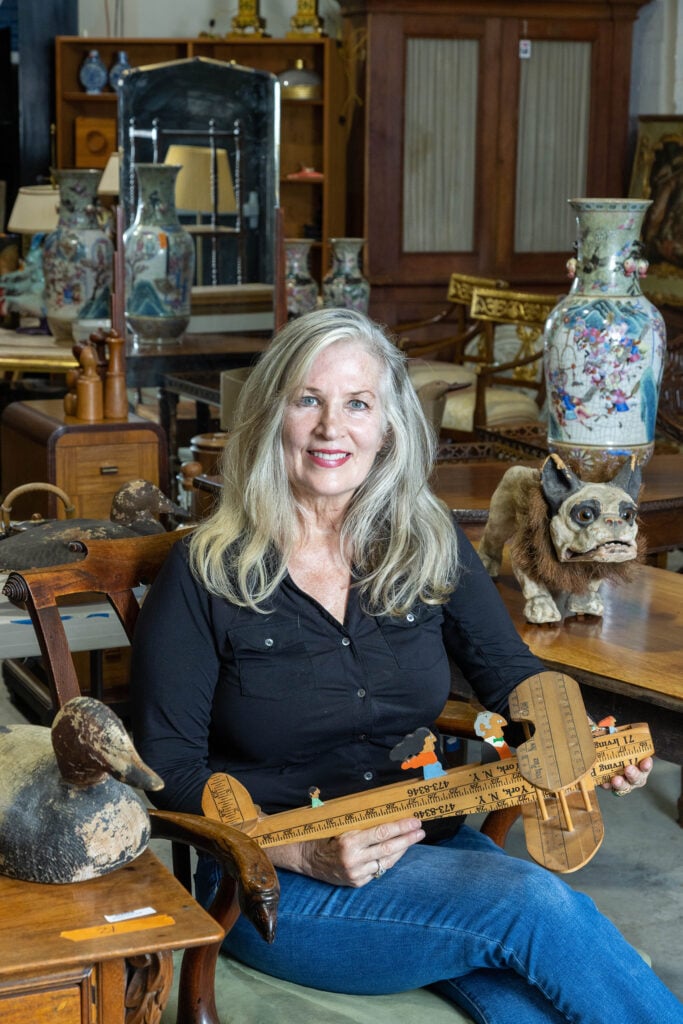
What’s hot now? According to Lori James, owner of Ararity Services, a downsizing-and-auction company in Alexandria, high-end art glass, Baccarat crystal, vintage Legos, rare vinyl records, designer clothing, furniture by the woodworker George Nakashima, and paintings by the late Gene Davis, a DC artist whose works are displayed at the National Gallery of Art and the Phillips. And, with precious metals at all-time highs, gold and silver. “Silver brings the dealers in, but it’s for weight,” says Patti Silverstein, a co-owner of Metropolitan Estate Sales in Lanham, which ran the Safire sale. “They come with their scales, they come with their acid.” Books have enjoyed a post-pandemic resurgence, reports Joanna Shreve Cady, owner of Bethesda’s Savvy Downsizing & Estate Sales. And, of course, anything midcentury modern, my preferred beat.
The voyeuristic thrill holds equal sway, at least for me. A novelist bereft of ideas need only spend a weekend visiting sales and the outlines of countless domestic dramas will emerge. Last year, I attended a sale at the Cathedral Heights house of a Los Angeles Times editor who, sometime in the 1990s, had opened a European bureau for the newspaper. Michelin and Blue guides to France, posters of Chartres, “French Made Easy” VHS tapes—everywhere the trappings of that expat life, from an age when newspaper correspondents oozed glamour.

A similar nostalgia informs tales from the golden age of estate sales. Karen Jones, owner of Greater Washington Estate Services, remembers one she did for Betty Beale, a gossip columnist for the Washington Star who died in 2006. In the attic, Jones found a suitcase full of letters. “Betty dear,” read one, “please don’t worry about the President’s shirt. You were so kind to have it cleaned. The flowers were lovely. Mamie.” An artifact from a dinner with the Eisenhowers, one of countless pieces of Beale ephemera that Jones unearthed and sold. In 2018, she hosted one for the late senator and astronaut John Glenn at his Potomac house. “People slept on the front lawn. There were helicopters overhead. I heard from every magazine: Newsweek, People,” she recalls. The Marine Corps Museum purchased one of Glenn’s flight jackets listed for $28,500. Silverstein remembers staging a sale in Bethesda for Edith Ronne, the first American woman to set foot on Antarctica: “We had penguins coming out the wazoo.” And one she hosted for two swingers in their fifties, who had a sex room in their house with belts, chains, and costumes. She and her team uncovered party photos as they prepped for the sale—artifacts from a secret life, one requiring discretion.
Post-pandemic, in-person sales seem, much like the items themselves, a relic. Online auction sites have proliferated—AuctionNinja, CTBids, MaxSold—making it easier to sell your own valuables or host an estate sale online, with pickup at the home for winning bidders. James, the co-owner of an estate-sale company before starting Ararity, launched her own auction house during Covid. Each week, she brings in about 15 truckloads of items from local estates and sells more than a thousand lots. “If there’s treasure in the house, this girl’s gonna find it,” says James, who once scored a $20,000 Picasso vase for $4 at a Maryland garage sale.
And yet the in-person sale has demonstrated surprising staying power. For one thing, the auction model makes less sense for inexpensive items: glassware, old games, knickknacks. For another, the community that’s developed around in-person sales remains a draw. “We missed our people,” says Shreve Cady about the pandemic hiatus. “It’s a different shopper who comes for the experience than one who’s looking online to add the perfect lamp to their living room.”

For those who fear that the estate-sale audience may be graying out, I present Maddy Brannon, a 34-year-old standup comic who began attending sales when she was decorating her Brightwood Park rowhouse with her husband. “All my art is from estate sales,” she says. “That’s how it started.” Lamps, rugs, side tables, glassware, a decorative goldfish bowl from a former Smithsonian employee: As Brannon post-ed her finds on social media, she discovered an audience—64,000 strong on Instagram—and now authors a weekly Substack blast spotlighting the best sales in the region.
I experienced the Brannon effect firsthand last October when I attended an Alexandria sale she featured with a heavyweight list of designer names: Louis Vuitton, Versace, Prada, Dior. The intrigue: The sale appeared to be for Corrine Brown, the former Democratic congresswoman from Florida who was charged with fraud for her involvement in a charity slush-fund scheme and served nearly three years in prison. The crowd skewed young; they sifted through the designer clothing with the insatiability of a fighter breaking fast. As for me, it marked the first time seeing a congresswoman’s bra.
In June, I encountered a listing for an estate sale unlike any I had ever seen. “I’m a performance artist, and I’m turning my post-marital estate sale into a filmed performance and documentary,” the Facebook ad read. “This is more than a sale. It’s a conversation about change, identity, sacrifice, and starting over.”
On a Sunday afternoon, I pulled up to a midcentury-modern house in Alexandria’s Waynewood neighborhood. The front lawn was filled with art, glassware, vintage barstools, Ikea chairs—everything that the host, Jodi Askew, was unable to squeeze into a Honda Fit before embarking on a cross-country road trip to start a new life, post-divorce, in Portland. The emotional backstory of a sale usually remains a veiled mystery—but not here.
“I was in a ten-year relationship with a really good man, and through the course of that relationship, I realized I was queer,” Askew, 31, who uses they/them pronouns, said in their living room turned studio, as a film crew recorded. “I didn’t really want the domestic life I thought I wanted.”
For five hours, a stream of shoppers/subjects sat with Askew and the film crew, sharing stories of love, loss, and self-discovery—a pandemic marriage to a man in Denmark gone wrong, the struggles of being queer in an immigrant family—as some of Askew’s friends logged sales outside. At one point, three recent college grads, one of them wearing a WHITE DUDES FOR HARRIS T-shirt, haggled over the price of a midcentury-style bedside table and a green bench—the trio had just moved to Bloomingdale and were furnishing a group house. Askew asked them if they wanted to be part of the documentary. One of them, sporting a mustache and a newly acquired cactus print, was game, and as his housemates loaded their purchases into a Subaru Outback, he discussed his first love and the challenges of getting sober.
How hard was it to part with so many possessions? “Seeing the things I procured at much simpler times in my life” left Askew “mourning that innocence.” But “having them live on with somebody else who sees them with fresh eyes feels beautiful.”
In early 2022, I found myself on the other side of a sale when my mother passed away. She had been a flea-market obsessive and had amassed a basement of finds in her New Jersey townhouse that she intended to resell but never got around to: Danish Modern furniture, sterling-silver flatware. I kept various heirlooms but called in an estate-sale company for the rest, a lifetime’s worth of possessions—vintage clothing purchased in London in the ’60s, the secretary desk from my childhood bedroom. I was grieving and vulnerable, needed someone I could trust, and had accepted that the commission—companies typically take 35 to 45 percent of the proceeds—was worth the convenience. And, for a little extra cash post-sale, the company recycled and donated the leftovers and trashed the final remainders, leaving an empty basement.
I didn’t attend the sale; I didn’t want to see the masses wrangling over my mom’s possessions. I don’t think she would have much liked it. But now when I visit a sale, I feel like I’m communing with her spirit, sharing in the chase. Especially at one precipitated by a death, I’m attuned to life’s evanescence, reminded that my time will also come.
Which brings me back to that rosewood bar cart. The Sunday after I attended the Safire sale, I got the call. I had won it. My local one-man furniture shop repaired the crack in the handle and refinished it. There was no obvious place for it in our house, so I decided to list it and found a buyer on Facebook Marketplace—a collector of midcentury furniture. I turned a small profit, and for a brief moment I owned a relic from old Washington, which will undoubtedly get handed down again, in a cycle of conservation that will continue long after I’m gone.
Estate-Sale Tips
Need to host a sale? Here are suggestions for finding a company.

Do Your Research
Few rules and restrictions govern the estate-sale business. For starters, check references and online reviews, and ask questions. “Do you have a business license? Are you insured ?” says Karen Jones of Greater Washington Estate Services. The American Society of Estate Liquidators offers certification; it lists qualified individuals on its website who have agreed to abide by the society’s code of ethics. Stories abound of dealers or friends and family of the company getting first crack at choice items before a sale, for example. You want someone who will look out for your best interests.
Get It in Writing
Make sure to sign a contract that considers all the potential contingencies of a sale and that lays out specific fees, if any, for cleaning post-sale or consigning or tossing leftover items.
Manage Your Expectations
Those shelves of Delft pottery that your mom collected as an investment? They now go for a song. Check recent sales on LiveAuctioneers.com or eBay or to get a sense of the going rate for antiques. Most companies will bring in appraisers to help price more obscure items.
Keep the Threads
A lot of people will offload all the clothing in a house before staging a sale. But that’s a mistake, says estate-sale influencer Maddy Brannon. Vintage clothing can draw people in: “It’s actually a pretty important piece of the sale.”
And if you’re looking to score a bargain, consider this advice:
Pick the Right Sales
Estate sales come in many forms. Some are expertly curated—they tend to have higher prices but more refined offerings. And some are glorified garage sales, with items tossed into boxes. Check out the listings and photos on EstateSales.net or Facebook Marketplace to get a sense of what a sale might have.
Make a Last-Minute Offer
Most sales run for two or three days over a weekend, and some companies drop prices by a predetermined amount each day: 50 percent off on the last day, for instance. Scoring a deal gets easier in the waning hours. For items with big sticker prices, companies may decide to consign them to auction, so be realistic when making a bid.
This article appears in the August 2025 issue of Washingtonian.

